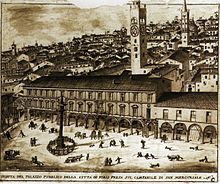Ignazio Cirri
(Forlì, 1711 – 1787)
Cirri was maestro di cappella from 1759 at the Cathedral of Santa Croce, now the Duomo in Forlì. In that same year he was granted entrance to the Philharmonic Academy in Bologna. He was already canon at the Duomo of Forlì since 1731. It is not certain whether his teachers included Giovanni Battista Martini who was only five years older. It is however known that the two were in friendly relations, that Martini became a member of the Philharmonic Academy in 1758, that Martini possessed, amongst his portraits of gentlemen of merit, also one of Cirri (the painting, anonymous, is today conserved in the Sala Bossi of the Conservatory “G. B. Martini” in Bologna) and that, lastly, a compositional affinity is evident in both their works. In 1780, for reasons of health and advancement of age, he was assigned the assistance of his already famous younger brother Giovanni Battista in the role of coadjutant. His works, besides numerous manuscripts, include the twelve Sonatas for Organ and Six Sonatas for harpsichord with violin accompaniment, that have never been recorded until now. Many of his compositions however remain unpublished and are currently conserved at the Archivio Capitolare of the Forlì Duomo. The style of the organ sonatas presents a certain harmonic and contrapuntal skill that distinguishes them from the contemporary Italian artistic style, such that the scholar Luigi Torchi defined it as a transition between Bach and Clementi.
“It is necessary for me to please, since that is what provides my bread, and furthermore I have always endeavoured to the extent of my abilities to not remain totally on the side of noise, but rather to side with that certain ‘harmony, that the talent of the ignorant of the Church, though in the absence indecency and shame, can find.”
(from a letter by Ignazio Cirri to padre G. B. Martini in 1767).
Program:
Sonate per clavicembalo con l’accompagnamento di violino op. 2
Sonata n. 1 in D major
Allegro spiritoso; Andante largo; Presto
Sonata n. 2 in G major
Allegro moderato; Andantino; Minuetto – Minuetto II
Sonata n. 3 in F major
Allegro; Andante cantabile; Allegro
Sonata n. 4 in F major
Allegro spiritoso; Andantino; Rondo – Allegretto
Sonata n. 5 in C major
Allegretto; Andante; Allegretto vivace
Sonata n. 6 in B flat major
Allegro moderato; Rondo allegretto; Fugato – Non tanto allegro
